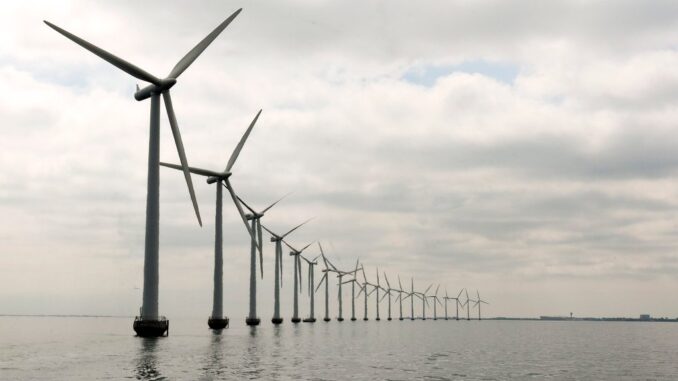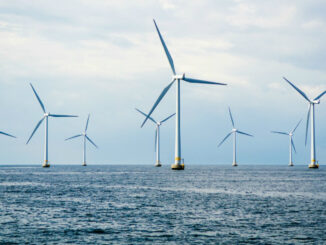
The following commentary was written by David Wooley, director of the Goldman School of Public Policy at the University of California-Berkeley. See our commentary guidelines for more information.
The Gulf Coast’s power grid and economy share a common need: diversity. Diverse electric generation supplies increase power system reliability and resilience in the face of rising demand and extreme weather. Diverse economic activity supports employment, expands the tax base and boost overall prosperity. Offshore wind could help achieve both goals for the Gulf Coast region — if state governments act.
Offshore wind is surging, with over 700 gigawatts in the global development pipeline. European nations plan to install at least 120 gigawatts of offshore wind by 2030 and 300 gigawatts by 2050. China added nearly 20 gigawatts of offshore wind in the last two years alone.
Those rising tides are also lifting American boats. On Aug. 29, the U.S. Bureau of Ocean Energy Management (BOEM) will hold an offshore wind energy lease sale for three areas on the Outer Continental Shelf in the Gulf of Mexico. In July, the nation’s first large-scale offshore wind plant began construction off the northeast coast. Twenty-nine U.S. ports are being refurbished to support offshore wind turbine construction and maintenance. Factories are going up across the U.S. to produce offshore wind energy components.
A new report — 2035 and Beyond: Abundant, Affordable Offshore Wind Can Accelerate Our Clean Electricity Future — shows our coastlines have the world’s highest-quality offshore wind resource. The new report details a pathway for offshore wind to provide up to 25% of total U.S. electricity generation by 2050, while producing large economic benefits and without increasing electricity costs. It could help meet rising electricity demand from electrification of transportation, industry, and buildings — which will triple U.S. electricity demand by 2050.
The U.S. is currently targeting 30 gigawatts of installed offshore wind generation by 2030. Our new research shows that offshore wind technology can be 10 to 15 times larger than that by 2050. Offshore wind along the Eastern seaboard, Gulf of Mexico, Great Lakes, and Pacific Coast can supply more than 1,000 gigawatts of generating capacity with operational characteristics comparable and complementary to existing power plant production (i.e., more than 50% capacity factor). This would create hundreds of thousands of new jobs nationwide and attract billions in investment to revitalize port and manufacturing communities.
The Gulf of Mexico is particularly well-suited for offshore wind deployment. The region could host more than 100 gigawatts of new offshore wind by 2050. With its existing manufacturing, port, and logistics infrastructure, and skilled workforce, the region could become a hub for new offshore wind generation. Many of the requisite offshore wind labor skills, ships, and port facilities can be adapted from existing Gulf offshore oil and gas industries. The Gulf of Mexico hosts most of the U.S. shipyards able to build wind turbine installation vessels. The region is already producing ships, turbine foundations, and steel components for offshore wind farms on the east coast.
New research by Cambridge Econometrics finds that offshore wind could employ 20,000 workers in the Gulf region by 2040 and 60,000 in 2050. Billions of grant and tax-credit dollars are available to repurpose existing infrastructure for jobs and clean energy production. The areas appropriate for offshore wind development in the Gulf are so vast that large amounts of offshore wind generation can be developed without interfering with fisheries, existing offshore infrastructure and sensitive marine ecosystems.
But offshore wind has far wider benefits than just jobs. Wind energy produced offshore can add large amounts of new electric power generation to bolster electric grid reliability — particularly important given Texas’ recent blackouts and near misses. Offshore wind in Gulf waters tends to kick up when solar production drops at sundown, and offshore wind turbines are less affected by extreme cold and heat events than land-based renewable and gas generation.
Several policy changes can achieve this potential. In the near term, the federal government must accelerate the identification and assessment of offshore wind sites, and leasing and permitting in federal waters. But state leadership is also needed to tap the Gulf Coast’s offshore wind potential.
Louisiana has shown its neighbors how to get started. Its 2022 Climate Action plan set a target of 5 gigawatts of installed offshore wind capacity by 2035, prioritized planning for transmission and workforce needs, established an interagency working group to address permitting, and enacted legislation to secure state tax revenues from offshore wind developed in state waters. Ports there have responded to the policy signals by making changes to accommodate offshore wind development and ships are being built in the state’s shipyards. Plans are in place to establish an offshore wind technology research, training, and technology demonstration center, but even all this isn’t enough to establish the state as an offshore wind hub.
A recent roundtable event organized by C2ES recommended, among other things, that the state take three steps. First, map out the unique roles each of Louisiana’s ports could play in the offshore wind industry. Second, open public utility commission dockets to consider how to interconnect and provide transmission support for new offshore wind projects. Third, undertake initiatives to prepare its workforce for offshore wind development.
Meanwhile, Texas stands in stark contrast, turning a blind eye to offshore wind energy, despite being desperately short of electricity during extreme winter and summer weather. The ultimate result may be that Louisiana’s ports and industries become the region’s offshore wind port and manufacturing hub for project development in waters off the Texas coast.
Texas’ policymakers could take a better approach by actively coordinating infrastructure and supply chain development with Louisiana, and pushing together for federal dollars to de-risk port and vessel construction through revenue guarantees for port and ship owners.
Punishing heat waves gripped the Gulf this summer, straining the electric grid to its limits. It’s a harbinger of things to come. Offshore wind can supply large new power supplies and help make electric power systems more reliable. The Gulf Coast states could be global leaders in this new industry, building a stronger economy and more resilient grid along the way.



